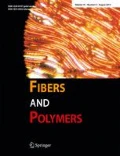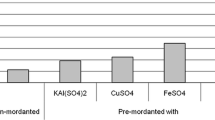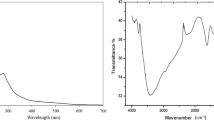Abstract
Natural dyes are gaining importance in textile dyeing applications in recent years due to the fact many synthetic dyes are carcinogenic, mutagenic, and allergic. In this study, cotton knitted fabrics were dyed with extract solutions of 40 different dye plants without the mordant usage. Afterwards color efficiency and fastness values of dyed samples were evaluated. Dye plants that are able to give good color efficiency with sufficient fastness values were determined. According to the experimental results it can be said that for yellow color pomegranate peel and turmeric; for red color madder and quince; for blue color indigo; for green color myrobalan; for brown color white onion peel and catechu give the optimum results. Furthermore, it was tested whether ultraviolet protection effect could be obtained via dyeing with white onion peel or turmeric and it was found that both of these plants gave very good UV protection functionalization to cotton fabrics.
Similar content being viewed by others
References
N. Sekar, Colorage, 46, 33 (1999).
D. Gupta, Colorage, 47, 23 (2000).
P. S. Vankar, Resonance, 5, 73 (2000).
M. L. Gulrajani, Colorage, 46, 19 (1999).
D. M. Lewis, “Wool Dyeing”, Bradford, West Yorkshire: Society of Dyers and Colourists, 1992.
S. Saxena and A. S. M. Raja in “Roadmap to Sustainable Textiles and Clothing — Eco-friendly Raw Materials, Technologies, and Processing Methods” (S. S. Muthu Ed.), pp.37–80, Springer, Singapore, 2014.
R. Atav and K. Karabulut, “Investigation of the Dyeability of Cotton Knitted Fabrics with Various Dye Plants in the Presence of Potassium Aluminum Sulfate Mordant”, International Conference on Engineering Technology and Innovation, Conference Proceedings Book, pp.57–64, Sarajevo-Bosnia and Herzegovina, 2017.
D. Cristea and G. Vilarem, Dyes Pigm., 70, 238 (2006).
A. Davulcu, H. Benli, Y. Şen, and M. I. Bahtiyari, Cellulose, 21, 4671 (2014).
H. Benli and M. I. Bahtiyari, J. Cleaner Prod., 89, 116 (2015).
H. Benli and M. I. Bahtiyari, Cellulose, 22, 867 (2015).
D. Gupta, S. K. Khare, and A. Laha, Color. Technol., 120, 167 (2004).
R. Rathinamoorthy, S. Udayakumar, and G. Thilagavathi, Int. J. Pharm. Sci. Nanotechnol., 4, 1549 (2012).
R. Rajendran, J. Text. Apparel Technol. Manag., 7, 1 (2011).
N. Reddy, S. Han, Y. Zhao, and Y. Yang, J. Appl. Polym. Sci., 127, 2698 (2013).
Y. H. Lee, E. K. Hwang, and H. D. Kim, Materials, 2, 10 (2009).
K. Karabulut and R. Atav, “Doğal Boyalarla Boyanmış Pamuklu Kumaşların Antibakteriyel Etkinliği”, pp.633–637, Uluslararası Geleneksel Sanatlar Sempozyumu, Proceedings, Trabzon, 2017.
S. N. Chattopadhyay, N. C. Pan, A. K. Roy, S. Saxena, and A. Khan, J. Text. Inst., 104, 808 (2013).
D. Grifoni, L. Bacci, G. Zipoli, L. Albanese, and F. Sabatini, Dyes Pigm., 91, 279 (2011).
M. Shahid, S. Islam, and F. Mohammad, J. Cleaner Prod., 53, 310 (2013).
A. K. Sarkar, BMC Dermatol., 4, 1 (2004).
D. Gupta, A. Jain, and S. Panwar, Indian J. Fibre Text. Res., 30, 190 (2005).
K. Kunttou, S. Hongyo, and S. Maeda, Text. Res. J., 75, 149 (2005).
ISO 105-C06, Textiles-Test for Colour Fastness, Part C06: Color Fastness to Domestic and Commercial Laundering, 2010.
ISO 105-X12, Textiles-Tests for Color Fastness, Part X12: Color Fastness to Rubbing, 1993.
ISO 105-E04, Textiles-Tests for Color Fastness, Part E04: Color Fastness to Perspiration, 1994.
ISO 105-B02, Textiles-Tests for Color Fastness, Part B02: Color Fastness to Artificial Light, 1994.
Z. Bilimis, “Measuring the UV Protection Factor (UPF) of Fabrics and Clothing”, pp.1–4, UV Instruments at Work, Varian-Australia Pty Ltd., Victoria 3170, Australia, 1994.
G. Savvidis, E. Karanikas, N. Nikolaidis, I. Eleftheriadis, and E. Tsatsaroni, Color. Technol., 130, 200 (2014).
B. H. Patel and D. P. Chattopadhyay, “Process Development for Printing on Cotton Fabric with Terminalia chebula Dye”, India, 2009.
S. B. Gokhale, U. Tatiya, S. R. Bakliwal, and R. A. Fursule, Natural Product Radiance, 3, 228 (2004).
M. Montazer, M. Parvinzadeh, and A. Kiumarsi, Color. Technol., 120, 161 (2004).
R. W. Sabnis, Handbook of Acid-Base Indicators, p.111, CRC Press, 2007.
M. F. Shahin, R. M. Ahmed, and M. M. Marie, Int. J. Eng. Res. Appl., 4, 35 (2014).
X. X. Feng, L. L. Zhang, J. Y. Chen, and J. C. Zhang, J. Cleaner Prod., 15, 366 (2007).
Author information
Authors and Affiliations
Corresponding author
Rights and permissions
About this article
Cite this article
Karabulut, K., Atav, R. Dyeing of Cotton Fabric with Natural Dyes without Mordant Usage Part I: Determining the Most Suitable Dye Plants for Dyeing and UV Protective Functionalization. Fibers Polym 21, 1773–1782 (2020). https://doi.org/10.1007/s12221-020-9365-2
Received:
Revised:
Accepted:
Published:
Issue Date:
DOI: https://doi.org/10.1007/s12221-020-9365-2




